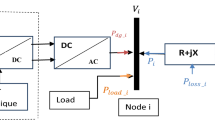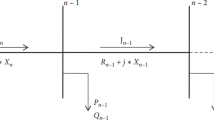Abstract
Distributed power grids generally contain multiple diverse types of distributed generators (DGs). Traditional particle swarm optimization (PSO) and simulated annealing PSO (SA-PSO) algorithms have some deficiencies in site selection and capacity determination of DGs, such as slow convergence speed and easily falling into local trap. In this paper, an improved SA-PSO (ISA-PSO) algorithm is proposed by introducing crossover and mutation operators of genetic algorithm (GA) into SA-PSO, so that the capabilities of the algorithm are well embodied in global searching and local exploration. In addition, diverse types of DGs are made equivalent to four types of nodes in flow calculation by the backward or forward sweep method, and reactive power sharing principles and allocation theory are applied to determine initial reactive power value and execute subsequent correction, thus providing the algorithm a better start to speed up the convergence. Finally, a mathematical model of the minimum economic cost is established for the siting and sizing of DGs under the location and capacity uncertainties of each single DG. Its objective function considers investment and operation cost of DGs, grid loss cost, annual purchase electricity cost, and environmental pollution cost, and the constraints include power flow, bus voltage, conductor current, and DG capacity. Through applications in an IEEE33-node distributed system, it is found that the proposed method can achieve desirable economic efficiency and safer voltage level relative to traditional PSO and SA-PSO algorithms, and is a more effective planning method for the siting and sizing of DGs in distributed power grids.






Similar content being viewed by others
References
Celli G, Ghiani E, Mocci S (2005) A multi-objective evolutionary algorithm for the sizing and sitting of distributed generation. IEEE Trans Power Syst 20(2):750–757
Chinese National Development and Reform Commission (2016) The 13th five-year plan outline. People’s Publishing House, Beijing
Chinese National Energy Administration (2016) The 13th five-year plan on wind power development. http://news.bjx.com.cn. Accessed 17 Mar 2016
Dai J, Wang S, Zhu J (2011) Power flow method for weakly meshed distribution network with distributed generation. Power Syst Prot Cont 39(10):37–41+46
Ding X, Zhou C, Yang B, Jiang X (2014) Sitting and sizing of distribution generation based on multi-population immune algorithm. Electr Meas Instrum 51(4):29–34
El-Khattam W, Hegazy YG, Salama MMA (2005) An integrated distributed generation optimization model for distribution system planning. IEEE Trans Power Syst 20(2):1158–1165
Hai X, Xu Y, Yao L (2011) Sitting and sizing of distributed generation based on immune generic algorithm in smart grid. Shaanxi Electric Power 39(12):58–61
Hejazi HA, Araghi AR, Vahidi B (2013) Independent distributed generation planning to profit both utility and DG investors. IEEE Trans Power Syst 28(2):1170–1178. https://doi.org/10.1109/TPWRS.2012.2219325
Huan S, Gao J, Luo D (2014) Design of direct drive permanent magnet wind generator and grid connected control. Electronics Industry Press, Beijing
Jagaduri T, Radan G (2007) Modeling and control of distributed generation systems including PEM fuel cell and gas turbine. Electr Power Syst Res 77(1):83–92. https://doi.org/10.1016/j.epsr.2006.02.003
Ji Z, Liao H, Wu Q (2009) Particle swarm algorithm and applications. Science Press, Beijing
Kennedy J, Eberhart R(1995) Particle swarm optimization. Proc IEEE Int Conf Neural Netw 1942–1948
Kaabi SA, Zeineldin H, Khadkikar V (2014) Planning active distribution networks considering multi-DG configurations. IEEE Trans Power Syst 29(2):785–793. https://doi.org/10.1109/TPWRS.2013.2282343
Li X, Peng Y, Zhao J (2009) Power flow calculation of distribution network with distributed generation. Power Syst Prot Control 37(17):78–81+87
Liang X, Huang M (2011) Modern intelligent optimization hybrid algorithm and its application. Science Press, Beijing
Lin B (2016) The 13th five-year plan on energy sector full resolution (wind energy). http://www.bjzq.com.cn. Accessed 17 Mar 2016
Liu B, Zhang Y, Yang N (2008) Improved particle swarm optimization method and its application in the siting and sizing of distributed generation planning. Trans China Electrotech Soc 23(2):103–107
Nissen MB (2009) High performance development as distributed generation. IEEE Potentials 28:25–31
Zhang Q (2008) The location and determination of distributed power source in grid planning. Dissertation, Shandong University
Sedghi M, Ahmadian A, Aliakbar-Golkar M (2016) Optimal storage planning in active distribution network considering uncertainty of wind power distributed generation. IEEE Trans Power Syst 31(1):304–316. https://doi.org/10.1109/TPWRS.2015.2404533
Wang C, Chen K, Xie Y, Zheng H (2006) Siting and sizing of distributed generation in distribution network expansion planning. Autom Electric Power Syst 30(3):38–43
Wang X, Zhao X, Cao J, Yuan X (2014) Optimization design for locating and sizing of distributed generation based on improved particle swarm algorithm. J Dalian Univ Technol 54(3):355–360
Wang Y (1995) An overview of priority methods of comparison matrix. J Decision Support Syst 5(3):101–114
Yan L, Xie Y, Xu J (2013) Improved forward and backward substitution in calculation of power distribution network with distributed generation. J Xi'an Jiaotong Univ 47(6):117–123
Yang T, Su H (2013) Improved Tabu search-particle swarm optimization algorithm and its application. Comput Simul 30(5):333–336+382
Zheng H, Hu X, Zheng M, Liu R (2013) An improved hybrid algorithm based on particle swarm optimization and simulated annealing and its application. Comput Technol Dev 23(7):26–30
Zhou J, Su H (2016) Back/forward sweep power flow calculation with distributed generation considering static load characteristics. Power Syst Prot Control 43(24):26–32
Zhu X, Zhang J, Liu W (2012) Power flow calculation of distribution system with distributed generation considering static load characteristics. Power Syst Technol 36(2):217–223
Author information
Authors and Affiliations
Corresponding author
Additional information
Responsible editor: Marcus Schulz
Rights and permissions
About this article
Cite this article
Su, H. Siting and sizing of distributed generators based on improved simulated annealing particle swarm optimization. Environ Sci Pollut Res 26, 17927–17938 (2019). https://doi.org/10.1007/s11356-017-0823-3
Received:
Accepted:
Published:
Issue Date:
DOI: https://doi.org/10.1007/s11356-017-0823-3




